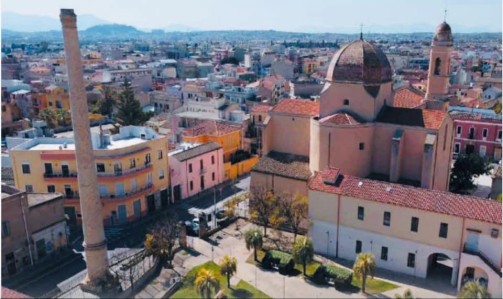Thirty thousand or so inhabitants and an area rich in history and tradition: these are some of the distinguishing features of Selargius. A municipality with a strong identity, encapsulated in part in the coat of arms shown in the banner and municipal insignia: a late Gothic marble cross on a column with Corinthian capital (sa cruxi ‘e marmuri), a vine shoot with a bunch of grapes, two ears of wheat and two flamingos in flight to recall the link with the nearby Molentargius pond and the now vanished Pauli pond. Wedged between Cagliari, Monserrato, Sestu, Settimo San Pietro and Quartucciu, the area holds important evidence of the pre-Nuragic period, especially at the site of Su Coddu/Cannelles, a locality on the outskirts of the town, where archaeological excavations have uncovered a vast settlement of Ozieri Culture (3,500-2,800 B.C.). But there is also no shortage of evidence from the Phoenician-Punic and Roman periods, dating back to the time when the town began to be an important center of salt harvesting. Several Campidanese houses, built with mud bricks(ladiri) and equipped with a porch(sa lolla) facing a large courtyard, are preserved in the historic center of the village. In Si ‘e Boi Square, next to the old distillery now converted into the Civic Theater, is the monumental parish dedicated to the Blessed Virgin of the Assumption, a sacred 15th-century building with a Latin cross plan. A visit to the nearby small church of San Giuliano, which houses a wooden crucifix from the late 16th century, is a must. Also worth mentioning are: the sanctuary of St. Lussorio, presumably built as early as the 12th century in Romanesque-Pisan forms and included among the Christian Sanctuaries of Italy; the modern country church of Santa Rosa built with sandstone masonry and equipped with a Latin cross plan. But Selargius has so much more to offer. First and foremost is Sa Coja Antiga, the chain wedding that has now become a must-attend event even outside regional borders. A fascinating event that has been repeated for almost a century with unchanged success, so much so that it has been included by the Autonomous Region of Sardinia among the events of regional interest. In terms of food and wine, great importance is given to the cultivation, harvesting and processing of capers, which are highly appreciated and in demand even abroad. The pride and joy of the area are also the durum wheat bread in the different varieties of daily bread(moddizzosu and civraxiu) and the festive bread(coccoi pintau or bride and groom bread), which is still decorated and chiseled with great care and dedication by Selargine women. As well as sweet almond, raisin, and sapa sweets, and wine , which, produced in large quantities since the first half of the 20th century, has enabled the area to win prestigious awards.


